
James Cook: the Explorer
Captain James Cook, the British explorer and cartographer, is the subject of the forthcoming exhibition James Cook: the Voyages which begins at the British Library on Friday 27th April 2018. Learn more about James Cook’s fascinating life, with images from the archive.

Portrait of Captain James Cook, 1775-76 (oil on canvas), Nathaniel Dance-Holland (1734-1811) / National Maritime Museum, London, UK
Jame Cook (born in 1728) came from humble beginnings, and joined the British merchant navy as a teenager and then the Royal Navy in 1755. He fought in the Seven Years’ War, and went on to survey and map the entrance to the Saint Lawrence River during the siege of Quebec. This brought Cook to the Admiralty and Royal Society’s attention, and led to his appointment in 1766 as commander of HM Bark Endeavour for the first of three Pacific voyages.
In these three voyages on the HMS Endeavour (1768-71), HMS Resolution (1772-75), and the HMS Discovery (1776-79), Cook sailed across thousands of miles of largely uncharted areas of the globe. He mapped lands in the Pacific Ocean – including Tahiti, New Zealand, Australia and Hawaii – in detail and on a scale not previously achieved. He recorded islands and coastlines on European maps for the first time. He was the first recorded European to have encountered the Eastern coast of Australia.
10 Captain James Cook facts:
1. Cook joined the Royal Navy late in life. He worked on a Yorkshire farm in his youth before winning an apprenticeship with a merchant sailing company at age 17. He was being groomed to become a captain, but in 1755 he shocked his superiors by quitting his merchant sailing career and enlisting in the British Royal Navy as a common seaman. Cook was 26, but it didn’t take long for the Navy to recognize his talent. He was promoted to ship’s master in only two years, and later became one of the first men in British naval history to rise through the enlisted ranks and take command of his own vessel.
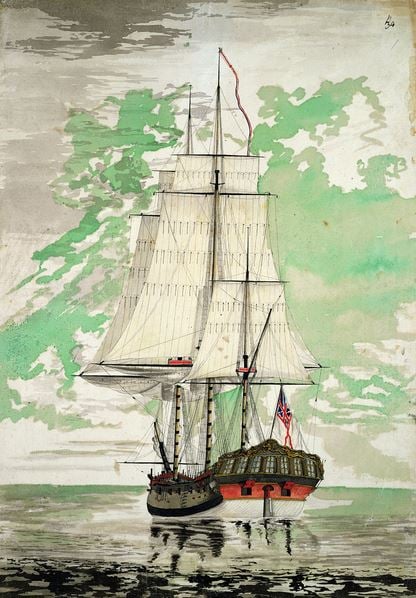
The Resolution, c.1775 (w/c), Roberts, Henry (c.1710-90) / Mitchell Library, State Library of New South Wales
2. Cook was an expert cartographer. It was his map making skills that brought him to the attention of the Navy after his detailed charts of Saint Lawrence River during the Seven Years’ War helped the British pull off a surprise attack again French-held Quebec. His talent at charting the sea was a crucial part of his skill set as an explorer, and it won him his first command of the around-the-world voyage on the HMS Endeavour, as he could be trusted to navigate uncharted territory and make precise maps of the lands he discovered. His maps were so accurate that they were still in use well in to the 20th century.
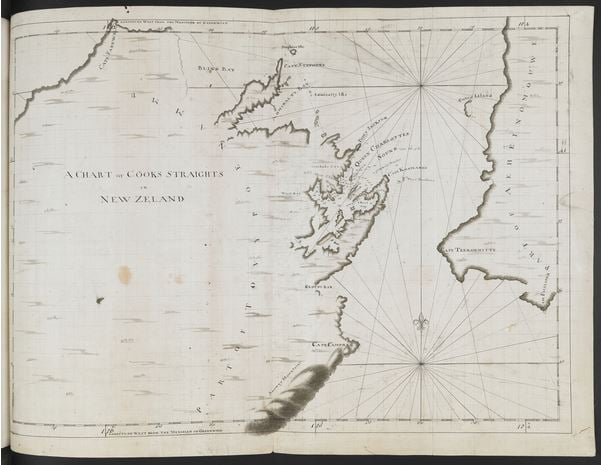
A chart of Cook’s Straits, in New Zealand; drawn by Lieut. James Cook, on a large scale (pen & ink on paper), Cook, James (1728-79) / British Library, London, UK
3. On his first voyage ((1768-71) Cook had two missions, one of which was a secret mission from the British government. The main mission was to observe the Transit of Venus across the face of the sun, but the secret mission had a military agenda. Cook had carried sealed orders instructing him to find the fabled “Great Southern Continent” – a land mass thought to be somewhere at the bottom of the globe. Cook eventually did find New Zealand which he circumnavigated thus proving the continent was in fact a pair of islands.
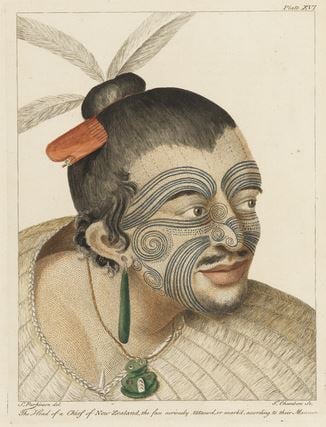
Illustration from ‘A journal of a voyage to the South Seas : in His Majesty’s ship, the Endeavour’, 1794 (hand-coloured engraving), Parkinson, Sydney (c.1745-71)
4. In June 1770, Cook’s ship almost sank on the Great Barrier Reef. This occurred when leaving the shores of Australia, having no idea he was heading into the razor sharp coral of the Great Barrier. Once the damage was done he had to return to Australia in order to carry out repairs, which took almost two months to complete.
5. Cook is credited with helping to pioneer new methods of keeping scurvy at bay. Scurvy (a disease caused by a lack of vitamin C) was a major cause of death on long sea voyages in the 18th century. Although Cook did not know the cause or cure for scurvy, he knew that sauerkraut – nutrient rich pickled cabbage – seemed to help keep scurvy at bay. Consequently he took several tons with him on his voyages for his crew to eat, and managed to keep all three of his expeditions nearly scurvy-free.
6. Cook was well respected even by Britain’s enemies. With such a good reputation world-wide, Cook was able to navigate the seas with relative freedom and impunity.
7. Cook searched for the Northwest Passage. In his third and final voyage in 1776 at the age of 47, Cook was tasked with the search for the Northwest Passage in the Arctic. The journey was a perilous one, but he did manage to come with 50 mile of the western entrance of the passage. However his attempt was thwarted by freezing weather and heavy ice floes in the Bering Sea and the mission had to be curtailed.
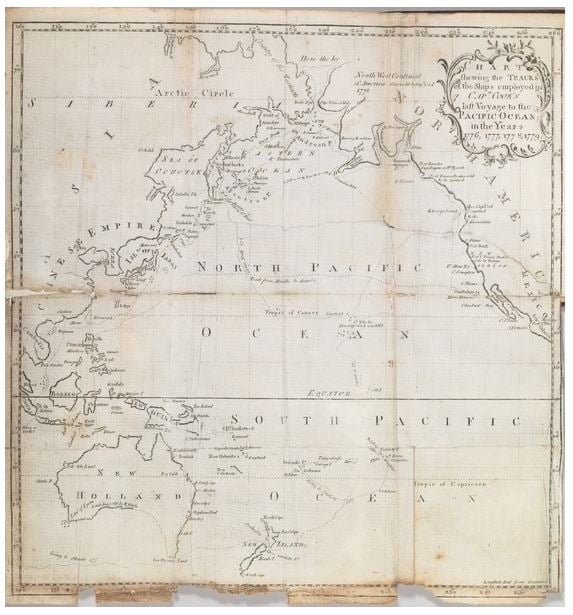
Frontispiece map from ‘A Journal of Captain Cook’s Last Voyage to the Pacific Ocean and in Quest of a North-West Passage Between Asia and America’ by John Ledyard, 1783 (engraving), American School, (18th century) / Private Collection / Christie’s Images
8. When Cook first landed in Hawaiian Islands in January 1779 he was mistaken for a god by the natives. They had never seen a white European before, or huge sailing ships, so assumed he and his men were deities and so lavished them with food and gifts (which they took full advantage of). It was only when one of the crew died of a stroke that the locals realised that they were not infact immortal, and thus began the deterioration of the relationship between Cook and the Hawaiians.
9. Cook was attacked and killed in 1779 on Hawaii. During his third exploratory voyage in the Pacific he attempted to kidnap Kalaniʻōpuʻu, a Hawaiian chief, in order to reclaim a cutter stolen from one of his ships. He was set upon by the local who feared for the life of their chief and was repeatedly stabbed and pelted with rocks. He was given the burial of a King by the Hawaiians after his death.
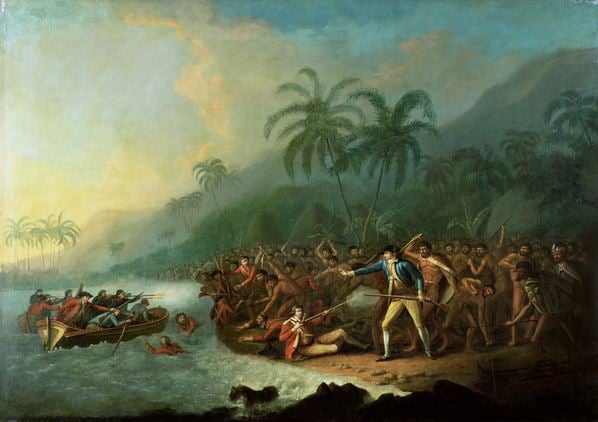
The Death of Cook, c.1781-83 (oil on canvas), Webber, John (1750-93) / Dixson Galleries, State Library of New South Wales
10. NASA named spacecraft after his ships. Endeavour, Discovery, were both names used for their shuttles. When the shuttle Discovery made its final space flight in 2011, its crew carried a special medallion made by the Royal Society in honour of Cook.
Find out more:
See more James Cook images from the British Libray here
See more James Cook images from the Library of New South Wales here
